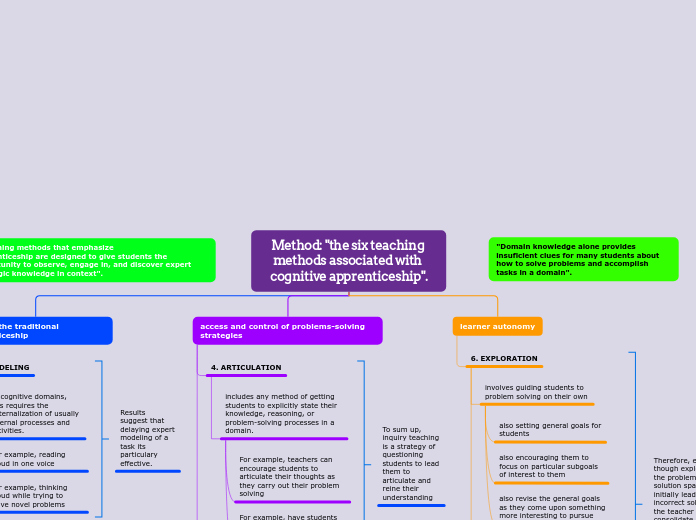Method: "the six teaching methods associated with cognitive apprenticeship".
Core of the traditional apprenticeship
1. MODELING
In cognitive domains, this requires the externalization of usually internal processes and activities.
For example, reading aloud in one voice
For example, thinking aloud while trying to solve novel problems
2. COACHING
Consist of observing students while they carry out task aimed to bringing their performance closer to expert performance.
In students while they formulate questions of the text
Clarify difficulties
Generate summary
Make predictions
3. SCAFFOLDING
refers to the supports the teacher provides to help student carry out a task
The supports are transient and only after the student is at an impase
For example, reciprocal teaching
For example, physical supports.
access and control of problems-solving strategies
4. ARTICULATION
includes any method of getting students to explicitly state their knowledge, reasoning, or problem-solving processes in a domain.
For example, teachers can encourage students to articulate their thoughts as they carry out their problem solving
For example, have students assume the critic or monitor
role in cooperative activities in order to articulate their ideas to other students
5. REFLECTION
involves enabling students to compare their own problem-solving
processes
with an expert
with another student
with a model of expertise
involves comparison's techniques
Replaying the performances to others for
Reading
writing
Problem solving
learner autonomy
6. EXPLORATION
involves guiding students to problem solving on their own
also setting general goals for
students
also encouraging them to focus on particular subgoals of interest to them
also revise the general goals as they come upon something more interesting to pursue
Furthermore
the teacher might send the students to the library to investigate and write
a teacher might ask students to design solutions to complex problems that target concepts they have not learned yet
Results suggest that delaying expert modeling of a task its particulary effective.
To sum up, some form of “abstracted replay,” in which the critical features of expert and student performance are highlighted, is desirable.
To sum up, inquiry teaching is a strategy of questioning students to lead them to articulate and reine their understanding
In conclusion, relates to specific problems that arise as the student attemps to acomplish a task
Research suggest that withholding support up front and providing it only after learners have failed to perform a task is very effective.
Therefore, even though exploration of the problem and solution spaces might initially lead to incorrect solutions, the teacher can consolidate and build on such an exploration to teach the targeted concepts
